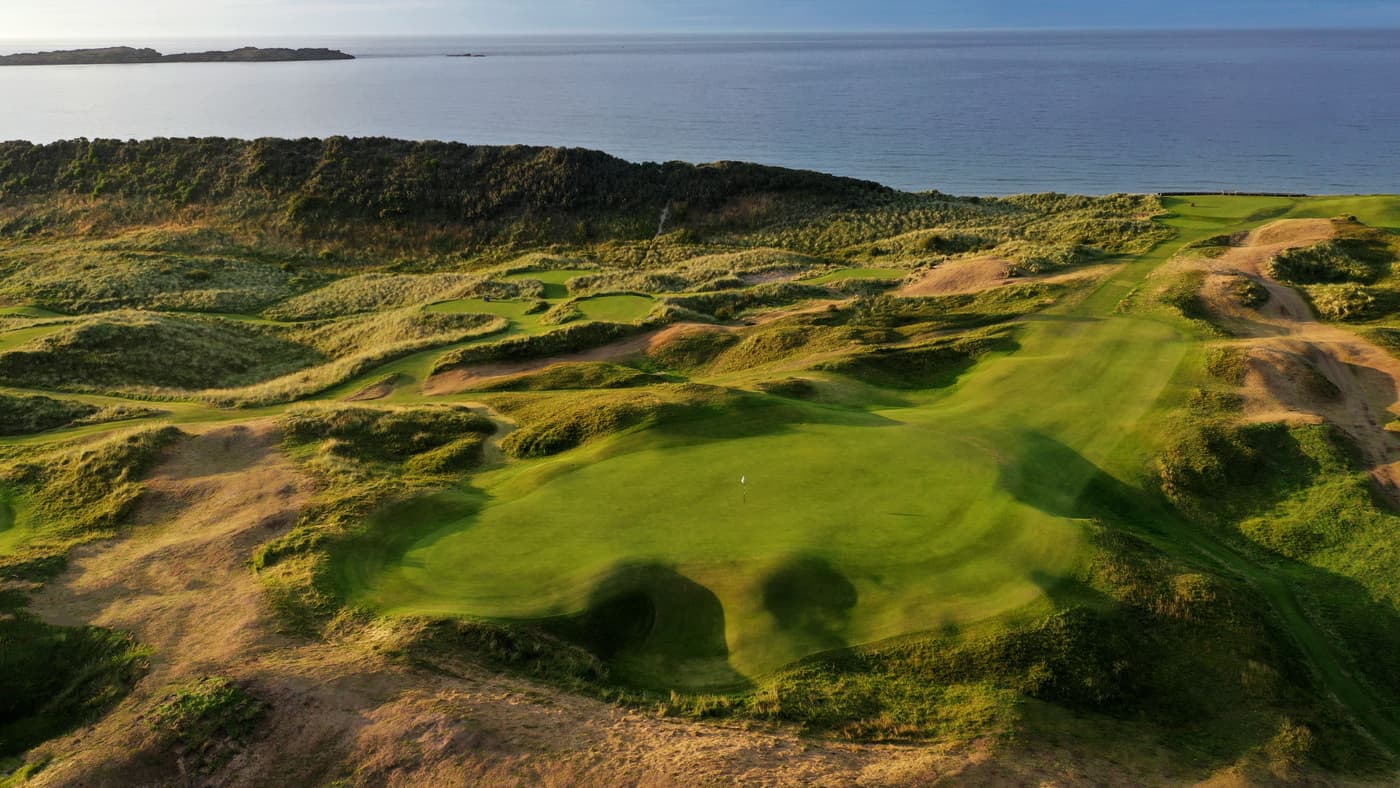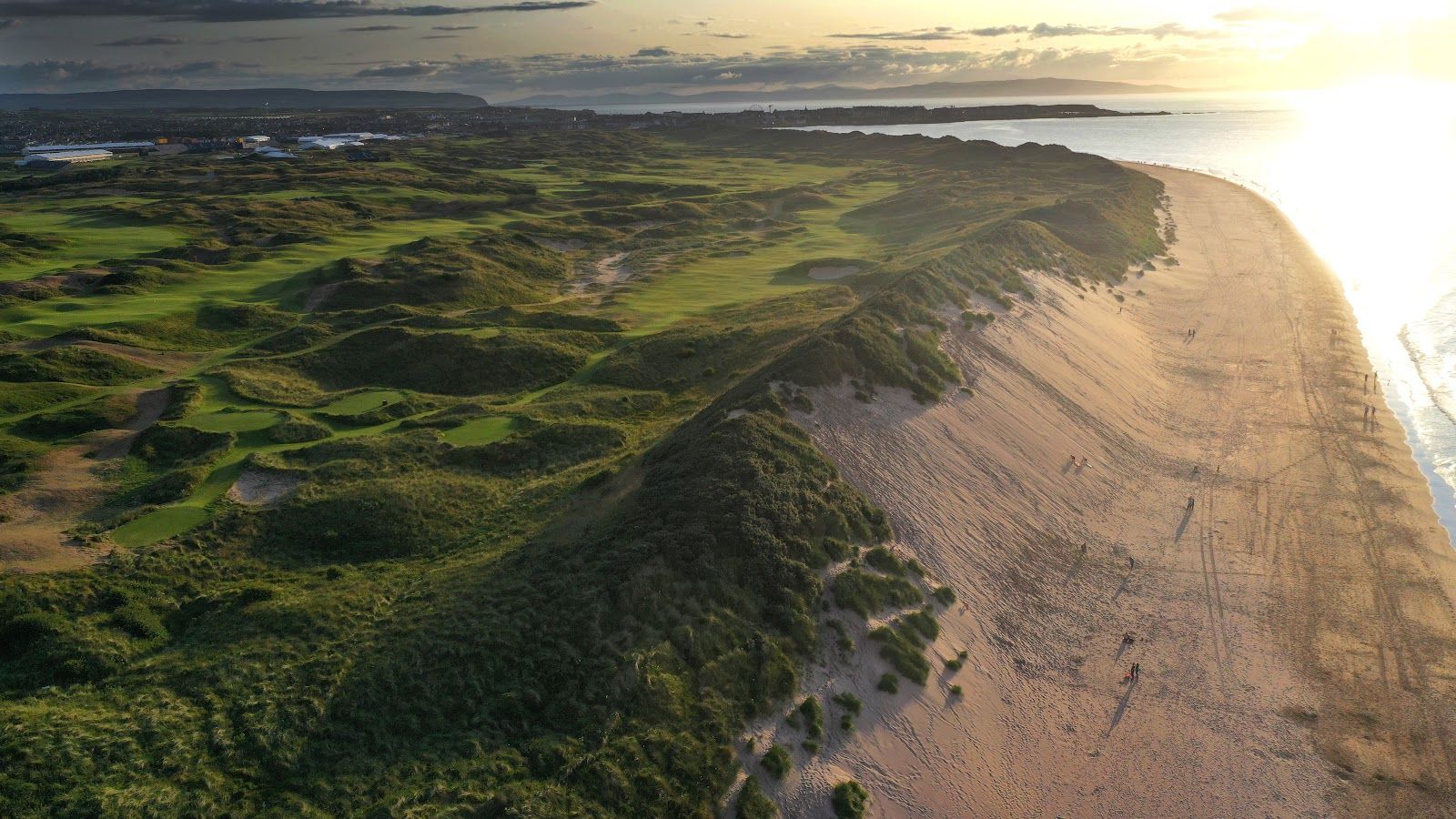
- AddressDunluce Rd, Portrush BT56 8JQ, UK
- Championships hosted
Royal Portrush has the honour of being the only club outside mainland Britain to host the Open Championship.
| Date | Winner | Country |
| 1951 | Max Faulkner | England |
| 2019 | Shane Lowry | Ireland |
"Portrush stands on a rocky promontory that juts out into the Atlantic, and, if I may allude to such trivialities," wrote Bernard Darwin in, The Golf Courses of the British Isles, "the scenery of the coast is wonderfully striking. On the east are the White Rocks, tall limestone cliffs that lead to Dunluce Castle and the headlands of the Giant's Causeway. On the west are the hills of Inishowen, beyond which lie Portsalon and Buncrana and the links of Donegal."
Since its foundation in 1888, Royal Portrush Golf Club has undergone a transformation in more ways than one. It was originally a 9-hole course, known as the County Club. The following year it was extended to 18 holes. In 1892, its name changed to the Royal County Club, with the Duke of York as patron. In 1895, the Prince of Wales came along and the name finally changed to Royal Portrush. Why who knows?
However, the biggest transformation came along when Harry S Colt redesigned the course in 1932, including two holes in an area known as “The Triangle”. Just before the Second World War, when it became apparent that the clubhouse would have to be relocated, the professional at that time, a Mr P.G. Stevenson, designed the current 10th and 11th holes, allowing the old 1st and 18th in the Triangle to be released. It would take until 1946 though before club members moved to their present premises, the former Holyrood Hotel.
The Dunluce links is named after the ruined Dunluce castle that overlooks the course. It was the venue for the first professional golf tournament in Ireland, won by Sandy Herd in 1895. Until 2019, The Open Championship has been held outside of Scotland and England only once; that occasion was here at Royal Portrush in 1951 when Max Faulkner triumphed. Faulkner was the last British Open champion until Tony Jacklin lifted the claret jug in 1969 at Royal Lytham & St Annes. More recently, American Pete Oakley won the Senior British Open here in July 2004.
In 2014 it was confirmed that Royal Portrush would return to the Open Championship rotation in 2019. 2011 Open Champion, Darren Clarke, was thrilled to hear that his home club will stage the tournament. “It is wonderful for the area, for Northern Ireland and the whole of Ireland that one of the biggest sporting events in the world is coming here," he said. “It's just massive, with pictures of Royal Portrush being beamed around the world to people who haven't seen how beautiful it is.”
Royal Portrush is certainly beautiful and it has one of the most dramatic entrances to any golf course. As you wind your way towards the course along the coastal road, the crumpled, undulating links land suddenly appears in front of you, flags fluttering in the breeze. It's a classic seaside links, located in an evocative setting on the north Antrim coastline, blessed with magnificent ocean views. On a clear day (from the 3rd tee) you can see the Paps of Jura and the island of Islay.
The fairways nestle in natural valleys between towering sand dunes. The small greens blend perfectly into the landscape, one of Colt’s masterstrokes. The greens are generally protected by natural grassy hummocks rather than sand bunkers, further adding to the understatement.
The most spectacular parts of the course are down by the shore. The 5th hole (called “White Rocks”) is an absolute stunner. It’s a short, downhill par four with a left to right dogleg. The elevated tee provides a platform to soak up the vista. The green is perched on the very edge of the course some 50 feet above the seashore. The 16th, called “Calamity”, is a 210-yard par three; a deep chasm to the right of the green makes it a nervous tee shot.
The Dunluce is a seriously tough cookie and requires solid driving to hold together a decent score. It will intimidate many golfers; the rough is penal (and sprinkled with heather and briar). It has very few bunkers but frankly, it doesn’t need them. The course has enough natural hazards to wreck a card, not to mention the ever-present wind. However, at all costs avoid "Big Nellie" at the new 7th—it's one of the biggest bunkers in Ireland.
A trip to the Giant’s Causeway may provide some respite after a gruelling round, followed by a nip of whiskey at nearby Bushmills, the world’s oldest distillery. Failing that, you could head directly to the first tee of the Valley course. It may be the second course at Royal Portrush but it’s a little cracker.
In preparation for the return of the Open, architects Mackenzie & Ebert proposed a number of course changes to the course, the most significant of which was the replacement of holes 17 and 18 on the Dunluce with two new holes, located where the old 5th and 6th holes lay on the Valley course.
The new hole 7 is a par five, played over much of the former 6th on the Valley course, but in the opposite direction. The famous “Big Nellie” bunker from the old 17th on the Dunluce has been recreated in the dunes to the right of this new fairway. The new par four 8th is then played from close to the tee boxes on the old Valley hole number 5, back to a green perched in the dunes at a slightly higher elevation.
Although the four par threes remain untouched, except for mowing the green further out at the back of “Calamity Corner”, additional tees and bunkers at several holes have been added, as well as extending the greens at holes 5 and (the newly sequenced) 15.
Mackenzie and Ebert commented as follows:
"As part of the course review exercise, investigation of the evolution of golf at Portrush was undertaken to assess how the layout had changed over the years and especially since Harry Colt laid out his final design for the Dunluce Course in 1932. That highlighted a fundamental issue. When Harry Colt designed the Dunluce in 1932, the clubhouse was over 1,200 yards away from the present clubhouse in the town of Portrush. Two of his original holes - the key 1st & 18th holes – had been lost. They provided a link from the old clubhouse to the current 17th and 18th. The existing 8th and 9th holes did not exist. Although Harry Colt was consulted over the addition of the replacement 8th and 9th holes, they were the conception of the Club’s professional, P.G. Stevenson, and Colt was not involved with the detail of the holes. This shows that Harry Colt was open to adjustments to the course required by changing circumstances.
The Club found themselves at another juncture of its evolution with the opportunities presented by the possibility of The Open Championship coming to Royal Portrush again. The Championship has grown in scale tremendously since Max Faulkner lifted the Claret Jug when the event was held over the links in 1951. If The Open was to make a return, The R&A were clear from the outset of the negotiations that sufficient room had to be available in the right areas to allow all of the usual infrastructure to be put in place to support the Championship. Following an intensive study of all options, the inescapable conclusion was drawn that the existing 17th and 18th holes of the Dunluce Course would have to be made available for the majority of the tented village area.
Following a detailed study of the opportunities to replace the 17th and 18th holes, the conclusion was that two replacement holes for the Dunluce could be forged from the area of the old 5th and 6th holes of the Valley Course. This will provide a tremendous arena for two dramatic and iconic holes which should quickly achieve world fame. The knock on effect was that replacement holes were required for the Valley Course. In fact three new Valley holes have been formed with the last of them giving incredible views to the beach and the sea, something which the old course did not enjoy. The Valley element of the project also involved the restoration of one of the original holes at Portrush.
It will be fascinating to see how the world’s best players handle the reconfigured links in July 2019."
Fittingly is was Irishman Shane Lowry who dominated the final two days of the 148th Open championship to win his maiden major title by six shots from England's Tommy Fleetwood amid exuberant scenes at Royal Portrush. Tough weather conditions on Sunday saw every contender fall away, allowing Lowry to cruise home for a comfortable victory.
Course Reviews
Leave a Review
This course has not been reviewed.
If you have played this course, consider .
Thanks for the review
Your review has been successfully submitted and will be reviewed for approval.
Course Reviewed
You’ve already submitted a review for this course.
Course Architect
View All
Harry Colt studied law at Clare College, Cambridge. Twelve months after his 1887 enrolment, he joined the committee of the Cambridge University Golf Club and in 1889 became the club's first captain.




